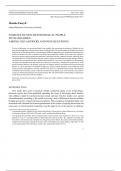STUDIA HUMANISTYCZNź AżH Tom ń5/4 • 2Ńń6
httpŚ//dx.doi.org/ńŃ.7494/human.2Ńń6.ń5.4.7
Monika Puszyk*
Adam Mickiewicz University in Pozna
ŻAMILIźS OŻ NON-HźTźROSźXUAL PźOPLź
WITH CHILDRźNŚ
AMONż OLD ANSWźRS AND NźW QUźSTIONS
The aim of this paper is to present and analyse the available data concerning the situation of children of non-
heterosexual people and to discuss selected areas of LżB parenting. The article enables an identification of issues
related to the welfare and specificity of functioning of children brought up by gays, lesbians and bisexual people,
which over almost forty years of research have finally been empirically verified. At the same time, it points to
the need to caution against generalizing particular conclusions from the conducted research, especially those
concerning the level of discrimination and peer violence against non-heterosexual people and their children,
on families living in Poland and other countries characterised by a low level of acceptance of LżB parenting.
The paper also identifies areas that should be of interest to researchers, including the perspective of social
parents and their relations with children, experiences of children raised by non-heterosexual men and bisexual
parents, as well as experiences of children brought up in family systems alternative to the traditional model
(a pair of parents with children). The data collected so far allow us to speak about safe context of development
of children raised in family systems created by non-heterosexual parents, and, at the same time, they point to
a space for educational programs and research projects that will enable further understanding of experiences
of non-heterosexual parents and their children.
KeywordsŚ non-heterosexual parents, children of same-sex couples, Rainbow Żamilies, psychosexual orien-
tation, LżB
INTRODUCTION
Over nearly forty years of research, initially conducted mainly in the United States,
numerous reports have been published expanding the scope of knowledge about families
with children created by non-heterosexual women and men. The first studies were carried
out predominantly according to the model of proving a lack of differences between children
brought up by hetero- and non-heterosexual parents. Their emergence and adopted shape were
associated with a demand for factual argumentation in the context of ongoing discussions and
court cases, in which parental competence and the right of one of the parentsń to childcare
* Corresponding authorŚ Monika Puszyk, Instytut Psychologii, Uniwersytet im. Adama Mickiewicza w Poznaniu,
ul. Szamarzewskiego 89AB, 6Ń-568 Pozna ś e-mailŚ monika.puszyk@amu.edu.pl.
ń
I am speaking here primarily about non-heterosexual women, because when parents get a divorce, in a vast
majority of cases it is considered that the child should stay with the mother. The argument associated with
the mother’s non-heterosexual orientation was frequently used by fathers, but also by other family members,
to deprive the divorcing (or already divorced) women of the right to raise their children, either alone or with
a new female partner with whom they created a new relationship (Tasker 2Ńń3Ś 3).
7
, MONIKA PUSZYK*
were questioned because of the parent’s psychosexual orientation. Therefore, a large part
of the scientific knowledge concerning the impact of a parent’s psychosexual orientation
on a child’s development derives from research conducted on children brought up by non-
heterosexual women and their new female partners, with whom they entered into a relationship
after separating from the child’s biological father (Tasker 2Ńń3Ś 3). The spectrum of scientific
reports was subsequently expanded by studies on families in which children were conceived
through modern reproduction techniques, or were incorporated into families created by
same-sex couples through adoption or foster care. There was an increase in the number of
studies conducted on large samples, of a longitudinal character and high methodological
standards, especially in countries characterised by more affirmative attitudes towards non-
traditional family patterns and non-heterosexual people. Nevertheless, as Kuhar and Takács
write, parenthood of non-heterosexual people continues to meet with more or less explicit
manifestations of lack of social recognition, which has an influence on the way people refer to
the results of the already conducted studies and on the formulation of new research projects on
LżBT (Lesbian, żay, Bisexual, Transgender) people’s families (Kuhar and Takács 2ŃńńbŚ ń5).
Researchers who take a negative attitude towards gays and lesbians and people who refer to
the results of their research, often overemphasise differences between children of hetero- and
non-heterosexual parents. There are also frequent attempts to reach unjustified conclusions,
unsupported by research, about the existence of a relationship between problems experienced
by a child (usually about the occurrence of mental disorders or experiences of sexual abuse)
and the parents’ psychosexual orientation, or being brought up in a non-traditional family.
In this context, one reaction of researchers, fearing that information included in their
publications can be used for political purposes, can be a minimisation of the importance of
differences observed in their studies. While these differences do not have to be synonymous
with the existence of deficits in the studied children, the researchers are often afraid that
conclusions from their studies, published in good faith, will be quoted as arguments against
non-heterosexual parents. Such a phenomenon can be observed, for example, in the case of
studies that report that children of non-heterosexual parents feel more free to reveal their
own homoerotic desires. Instead of resulting in a greater level of acceptance and support
from parents, it is interpreted by the opponents of LżB parenting as “socialising towards
homosexuality” (Kuhar and Takács 2ŃńńaŚ ń39). As a matter of fact, it should be emphasised
that although we do not still have sufficient data on what the sexuality of children of non-
heterosexual parents will be in adulthood, there is already a body of studies that enables us
to speak about safe development of children in family environments created by such parents
(Kuhar and Takács 2ŃńńaŚ ń39).
CHILDRźN OŻ NON-HźTźROSźXUAL PARźNTS –
OVźRVIźW OŻ THź źXISTINż SCIźNTIŻIC RźPORTS
The American Psychological Association, in a statement supporting non-heterosexual
parenthood, has cited the results of studies conducted since the ń98Ńs in the United States
and źurope. The empirical basis of the statement issued by the APA, however, has been
8




